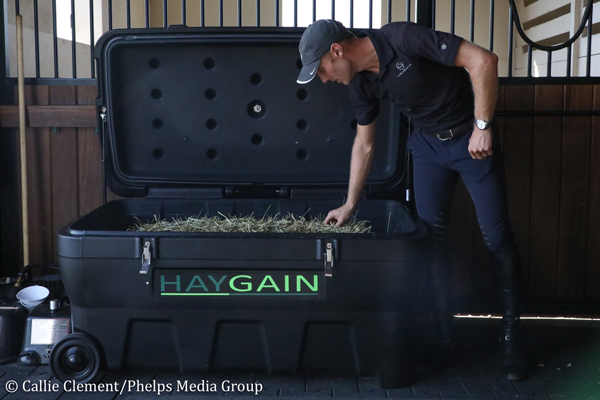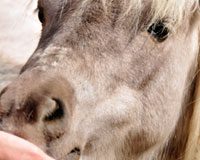Advertorial
“Cooked hay?” That’s what four-time Olympic dressage rider Ashley Holzer asked when a friend recommended steamed hay two years ago. Even though high-temperature hay steaming has been available for over 10 years, Ashley wasn’t the only equestrian unfamiliar with its many benefits. Ashley has since become a big believer, as have equestrians around the world—from Olympians to regular horse owners.
Well, the short answer is that hay can be harmful to your horse because it contains microscopic bits of mold, dust, fungi, bacteria and other pathogens and allergens. This is true even of hay that looks and smells great and has top nutrient quality. Storing hay can increase the quantity of all these particles that are present from the get-go because of the way hay is grown, harvested and transported.
All of these inhalable particles can harm a horse’s respiratory and digestive system and increase susceptibility to developing more severe conditions.

Steamed hay was developed by Haygain in conjunction with the Royal Agricultural University in the U.K., in 2009. The goal was to eliminate these unhealthy elements without leaching important nutrients, as happens with the messy and laborious process of soaking hay.
Numerous and ongoing studies demonstrate Haygain Steamed Hay’s ability to improve horses’ respiratory and digestive health, hydration, appetite, skin health, and performance.
Respiratory Health
Steaming eliminates up to 99% of the dust, mold, bacteria and allergens found in hay. All of these are the main source of respiratory issues that affect a surprisingly high percentage of active sport horses: over 80% and often without obvious symptoms.
In March of 2019, The Journal of Veterinary Internal Medicine published a study in which 88% of the 731 participating sport horses suffered from inflammatory airway disease (IAD), a condition on the Equine Asthma Spectrum. The horses that were fed Haygain Steamed Hay had a 65% reduced risk of IAD. The study attributed this to steaming’s ability to kill fungi in hay, which has a high correlation to IAD.
As with all aspects of horse health, prevention is the best medicine. Steamed hay is a great step for maintaining respiratory health and for helping horses with existing issues live and perform comfortably.
Castle Larchfield Purdy, a 2016 Olympic eventer with Lauren Billys, is a classic example. His mild case of Inflammatory Airway Disease is managed so effectively with steamed hay’s help that he’s met the rigorous qualifications for the Tokyo Olympics.
Digestive Health
Pathogens commonly found in hay can trigger significant digestive health issues like colic and ulcers. Clean hay reduces these risks and improves the digestive tract’s ability to digest and absorb nutrients.
Hay steaming also increases hydration. Dehydration can be life-threatening, in part because clinical signs are often not noticed until the condition is at a very advanced stage. One study found that steamed hay increases water consumption by three times.
Palatability
Four independent palatability studies and owners’ anecdotal reports indicate that most horses prefer the taste of steamed hay. That’s why veterinarians like it for horses coming out of surgery: the appealing taste and smell helps patients get back on their nutrition plan, aiding their overall recovery.
Good-tasting hay also helps prevent ulcers because it keeps horses chewing and eating more and for longer periods of time. That mimics what nature intended for the digestive process of these grazing animals.
Stopping The Allergy Spiral
Like people, horses are subject to allergic responses to a multitude of airborne particles found in the stabling environment. Because a horse that’s suffered from one allergy is more susceptible to another, it’s critical to remove allergens to every extent possible.
It’s even more important for horses with insect bite hypersensitivity because that goes hand-in-hand with increased airway hypersensitivity. This can make a horse more vulnerable to the allergens in hay.
Performance
After soundness issues, many veterinarians put respiratory function as the biggest performance limiter in otherwise healthy horses. Which, in a way, is good because so much can be done to protect and improve it. Feeding Haygain Steamed Hay decreases exposure to potentially harmful allergens, pathogens and other bacteria, improving overall health and performance.
And that’s why steamed hay is now a foundation of healthy horse management.
For more information, please visit www.Haygain.us. Or find them on Facebook, Twitter, Instagram, or YouTube.






